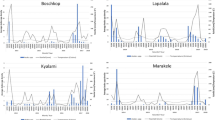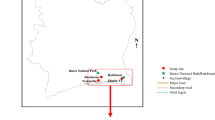Abstract
Transmission of arboviral diseases such as those caused by dengue, chikungunya and West Nile viruses involves hematophagous insects. Arbovirus transmission is a complex process in which host selection plays an important role that determines the contact rates between vulnerable hosts and infective vectors. This paper describes host selection of Aedes aegypti (Linnaeus) (Diptera: Culicidae) and Culex quinquefasciatus in suburban neighborhood houses located in the semi-desert environment of northern Mexico. All bloodmeal analyses were completed in engorged females collected by means of BG-GAT (BIOGENTS ®) traps and blood identification was made through PCR analysis using cytochrome b as reference gene. The results show that Ae. aegypti is feeding primarily on birds from the Galliformes and Columbiformes orders. On the other hand, Culex quinquefasciatus exhibits the same behavior as Ae. aegypti, selecting Galliformes as the main blood source group but exhibits different behavior regarding humans, feeding preferentially on humans over non-human mammals. Regarding resource utilization, Ae. aegypti had a broader niche (0.79) than Cx. quinquefasciatus (0.46). Pianka´s niche overlap index (0.79) showed that both species share many common hosts. Host selection for the mosquito species analyzed were found to be atypical from what is reported in the literature, which could have an impact on the vectorial capacity of the mosquitoes within the study area.




Similar content being viewed by others
Data Availability
Data transparency, we have all data and material available.
References
Apperson CS, Harrison BA, Unnasch TR, Hassan HK, Irby WS, Savage HM, Aspen SE, Watson DW, Rueda LM, Engber BR, Nasci RS (2002) Host feeding habits of Culex and other Mosquitoes (Diptera: Culicidae) in the Borough of Queens in New York City, with characters and techniques for identification of Culex Mosquitoes. Ann Entomol Soc Am 39(5):777–785. https://doi.org/10.1603/0022-2585-39.5.777
Azmi SA, Das S, Chatterjee S (2015) Seasonal prevalence and blood meal analysis of filarial vector Culex quinquefasciatus in coastal areas of Digha, West Bengal, India. J Vector Borne Dis 52:252–256
Bhatt S, Gething PW, Brady JP, Messina OJ, Farlow AW, Moyes CL, Drake JM, Brownstein JS, Hoen AG, Sankoh O, Myers MF, George DB, Jaenisch T, Wint GRW, Simmon CP, Scott TW, Farrar JJ, Hay SI (2013) The global distribution and burden of dengue. Nature 496(7446):504–507. https://doi.org/10.1038/nature12060
Bowman NM, Akialis K, Cave G, Barrera R, Apperson CS, Meshnick SR (2018) Pyrethroid insecticides maintain repellent effect on knock-down resistant populations of Aedes aegypti mosquitoes. PLoS One 13(5)
Canals M, Cruzat L, Molina MC, Ferreira A, Cattan PE (2001) Blood Host Sources of Mepraia spinolai (Heteroptera: Reduviidae), Wild Vector of Chagas Disease in Chile. J Med Entomol 38(2):303–307
Chaves L, Harrington L, Keogh C, Nguyen A, Kitron U (2010) Blood feeding patterns of mosquitoes: random or structured. Front Zool 7(3):1–11
Darsie R, Ward R (2005) Identification and geographical distribution of the mosquitoes of North America, North of Mexico. University Press of Florida, FL Mosquito Systematics, p 383
Day J (2005) Host seeking strategies of mosquito disease vectors. J Am Mosq Control Assoc 21(4):17–22
De Cicero C, Johnson NK (2001) Higher-level phylogeny of new world vireos (aves: vireonidae) based on sequences of multiple mitochondrial DNA genes. Mol Phylogenetics Evol 20(1):27–40
Diario Oficial de la Federacion (2014) Norma Oficial Mexicana NOM-032-SSA2-2014. Para la vigilancia epidemiologica, prevencion y control de enfermedades transmitidas por vector
Egizi A, Healy SP, Fonseca DM (2013) Rapid blood meal scoring in anthropophilic Aedes albopictus and application of PCR blocking to avoid pseudogenes. Infect Genet Evol 16:122–128. https://doi.org/10.1016/j.meegid.2013.01.008
Faraji A, Gaugler R (2015) Experimental host preference of diapause and non-diapause induced Culex pipiens pipiens (Diptera: Culicidae). Parasit Vectors 8(389):1–8. https://doi.org/10.1186/s13071-015-1012-1
Faraji A, Egizi A, Fonseca DM, Unlu I, Crepeau T, Healy S, Gaugler R (2014) Comparative host feeding patterns of the Asian tiger mosquito, Aedes albopictus, in urban and suburban northeastern USA and implications for disease transmission. PLoS Negl Trop Dis 8(8):1–11. https://doi.org/10.1371/journal.pntd.0003037
Fritz M, Walker E, Miller J, Severson D, Dworkin I (2015) Divergent host preferences of above- and below-ground Culex pipiens mosquitoes and their hybrid offspring. Med Vet Entomol 29(2):115–123. https://doi.org/10.1111/mve.12096
Garcia-Rejon J, Blitvich B, Farfan-ale J, Loroño-Pino MA (2010) Host-feeding preference of the mosquito, Culex quinquefasciatus, in Yucatan State, Mexico. J Insect Sci 10(32):1–13. https://doi.org/10.1673/031.010.3201
Gray TJ, Webb CE (2014) A review of the epidemiological and clinical aspects of West Nile virus. Int J Gen Med 7:193–203. https://doi.org/10.2147/IJGM.S59902
Gu W, Unnasch TR, Katholi CR, Lampman R, Novak R (2008) Fundamental issues in mosquito surveillance for arboviral transmission. Trans R Soc Trop Med Hyg 102(8):817–822. https://doi.org/10.1016/j.trstmh.2008.03.019
Harrington LC, Edman JD, Scott T (2001) Why do female Aedes aegypti (Diptera: Culicidae) feed preferentially and frequently on human blood? J Med Entomol 38(3):411–422
Hernandez- Acosta E (2016) Estatus epidemiológico de enfermedades virales transmitidas por Aedes aegypti (Díptera:Culicidae) en el norponiente de Ciudad Juárez, Chihuahua. Dissertation, Universidad Autónoma de Ciudad Juárez
Hess A, Haves R, Tempelis C (1968) The use of the forage ratio technique in mosquito host preference studies. Mosq News 28–3:386–389
INEGI (2015) Instituto Nacional de Estadística y Geografía (México). Anuario estadístico y geográfico de Chihuahua 2015, p 508
Kelly D (2001) Why are some people bitten more than others? Trends Parasitol 17(12):578–581
Kilpatrick M, Daszak JM, Marra P, Kramer L (2006) Host heterogeneity dominates West Nile virus transmission. Proc R Soc Lond B Biol Sci 273:2327–2333
Klun JA, Khrimian A, Debboun M (2006) Repellent and deterrent effects of SS220, Picaridin, and deet suppress human blood feeding by Aedes aegypti, Anopheles stephensi, and Phlebotomus papatasi. J Med Entomol 43(1):34–39
Labeaud A, Sutherland L, Muiruri S, Muchiri E, Gray L, Zimmerman P, Hise A, King C (2011) Arbovirus prevalence in mosquitoes, Kenya. Emerg Infect Dis 17:233–241. https://doi.org/10.3201/eid1702.091666
Loya Fierro O (2017) Importancia de las especies del género Culex como portadoras activas del Virus del Oeste del Nilo. Dissertation, Universidad Autónoma de Ciudad Juárez
Lyimo I, Ferguson H (2009) Ecological and evolutionary determinants of host species choice in mosquito vectors. Trends Parasitol 25(4):189–196
McBride C, Baier F, Omondi A, Spitzer S, Lutomiah J, Sang R, Ignell R, Vosshall L (2014) Evolution of mosquito preference for humans linked to an odorant receptor. Nature 515(7526):222–227. https://doi.org/10.1038/nature13964
Molaei G, Andreadis T, Armstrong PM, Anderson J, Vossbrinck C (2006) Host feeding patterns of Culex mosquitoes and West Nile virus transmission, northeastern United States. Emerg Infect Dis 12(3):468–474. https://doi.org/10.3201/eid1203.051004
Mukwaya L (1977) Genetic control of feeding preferences in the mosquitoes Aedes (Stegomyia) simpsoni and Ae. aegypti. Physiol Entomol 2:133–145
Ngo K, Kramer LD (2003) Identification of mosquito bloodmeals using polymerase chain reaction (PCR) with order-specific primers. J Med Entomol 40(2):215–222
Pan American Health Organization. Dengue Cases. Available from: https://www.paho.org/data/index.php/es/temas/indicadores-dengue/dengue-nacional/9-dengue-pais-ano.html. Accessed 18 Apr 2020
Ponlawat A, Harrington L (2005) Blood feeding patterns of Aedes aegypti and Aedes albopictus in Thailand. J Med Entomol 42(5):844–849
Scott TW, Amerasinghe PH, Morrison AC, Lorenz LH, Clark GG, Strickman D, Kittayapong P, Edman JD (2000) Longitudinal studies of Aedes aegypti (Diptera: Culicidae) in Thailand and Puerto Rico: blood feeding frequency. J Med Entomol 37:89–101. https://doi.org/10.1603/0022-2585-37.1.77
Secretaria de Salud. Medidas practicas para prevenir la picadura de mosquitos (2016) Available from: https://www.gob.mx/salud/acciones-y-programas/medidas-practicas-para-prevenir-la-picadura-de-mosquitos. Accessed 9 May 2020
Sivan A, Shriram A, Sunish I, Vidhya P (2015) Host-feeding pattern of Aedes aegypti and Aedes albopictus (Diptera: Culicidae) in heterogeneous landscapes of South Andaman, Andaman and Nicobar Islands, India. J Parasitol Res 114:3539–3546. https://doi.org/10.1007/s00436-015-4634-5
Smith DT, Perkins A, Reiner R, Barker C, Niu T, Chaves L, Ellis GD, Menach A, Pulliam J, Bisanzio D, Buckee C, Chiyaka C, Cummings D, Garcia A, Gatton M, Gething P, Hartley D, Johnston G, Klein E, Michael E, LLloyd A, Pigott D, Reisen W, Ruktanonchai N, Singh B, Stoller J, Tatem A, Kitron U, Hay SI, Scott TW, Simith DL (2014) Recasting the theory of mosquito-borne pathogen transmission dynamics and control. Trans R Soc Trop Med Hyg 108(4):185–197. https://doi.org/10.1093/trstmh/tru026
Syed Z (2015) Chemical Ecology and Olfaction in arthropod Vectors of diseases. Curr Opin Insect Sci 10:83–69. https://doi.org/10.1016/j.cois.2015.04.011
Takken W, Verhulst N (2013) Host preferences of blood-feeding mosquitoes. Annu Rev Entomol 58:433–453. https://doi.org/10.1146/annurev-ento-120811-153618
Thiemann T, Lemenager D, Kluh S, Carroll B, Lothrop H, Reisen W (2012) Spatial variation in host feeding patterns of Culex tarsalis and the Culex pipiens complex (Diptera: Culicidae) in California. J Med Entomol 49(4):903–916
Tisgratog R, Tananchai C, Juntarajumnong W, Tuntakom S, Bangs MJ, Corbel V, Chareonviriyaphap T (2012) Host feeding patterns and preference of Anopheles minimus (Diptera: Culicidae) in a malaria endemic area of western Thailand: baseline site description. Parasit Vectors 5(114):1–11. https://doi.org/10.1186/1756-3305-5-114
Uc-Puc V, Herrera-Bojórquez J, Carmona-Carballo C, Che-Mendoza A, Medina-Barreiro A, Chablé-Santos J, Arredondo-Jimenez J, Flores-Suárez A, Manrique-Saide P (2016) Efectividad de repelentes comerciales disponibles contra el mosquito Aedes aegypti (L.) en Yucatán, México. Salud Publ Mex, pp 472–475
Vogels C, Fros J, Pijlman G, van Loon J, Gort G, Koenraadt C (2017) Virus interferes with host-seeking behaviour of mosquito. J Exp Biol 220:3598–3603
Weaver S, Barret A (2004) Transmission cycles, host range, evolution and emergence of arboviral disease. Nat Rev Microbiol 2(10):789–801
Author information
Authors and Affiliations
Contributions
The above authors acknowledge the activities realized in the present manuscript. Alan Esteban Juache made the experimental procedure and wrote the manuscript, Florinda Jiménez was the professor that planning the molecular diagnostic and all the laboratory procedures and Antonio de la Mora contributed in the design of fieldwork, and reviewing of the manuscript and Angélica Escárcega was the professor that made the statistical analysis and reviewing of the manuscript.
Corresponding author
Ethics declarations
Conflict of interest
The authors declare that they have no conflict of interest.
Ethics approval
This work was approved by the bioethics committee of the Autonomous University of Ciudad Juarez CBE-ICB-071-10-15.
Rights and permissions
About this article
Cite this article
Juache-Villagrana, A.E., De la Mora-Covarrubias, A., Escárcega-Ávila, A. et al. Host selection of Aedes aegypti and Culex quinquefasciatus females in a semi-desert environment in Northern Mexico. Int J Trop Insect Sci 41, 55–63 (2021). https://doi.org/10.1007/s42690-020-00175-y
Received:
Accepted:
Published:
Issue Date:
DOI: https://doi.org/10.1007/s42690-020-00175-y




